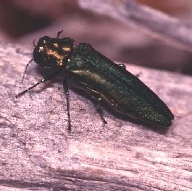The Problem
The emerald ash borer is a tremendously damaging invasive pest. In its native range of eastern Asia, it seems to be a minor pest, here in North America, it has proven to be a relentless killer of ash trees.
This beetle is harmful for three reasons:
- It has no effective native enemies in North America
- It attacks and kills healthy trees
- Our native ash have very little resistance to it
While woodpeckers will eat the larvae, they are not fast or efficient enough to curtail the spread of established beetle populations. Infested trees usually show dieback or yellowing of their canopies and sucker growth, followed by peeling bark and finally death in as little as 1-3 years.
Approximately 99% of ash trees in an infested region die within 6 years of initial beetle arrival. Emerald ash borer was first found in Canada in 2002 in Windsor, Ontario. Since then, it has spread to most of the St. Lawrence region despite best efforts to destroy or contain its spread. The presence of the borer was confirmed in Winnipeg in 2017, and in Vancouver in 2024. Similar infestations have taken hold in much of the USA, and the beetle is expected to continue to expand its range. The transportation of wood products, especially firewood, is a major factor in this spread.
While there is no native ash forest in Alberta, approximately 20% of the inventoried boulevard and open space trees in Edmonton are ash. Ash trees are also found on private property. Because of this, much of our urban forest is at serious risk. If left unchecked, emerald ash borer could cause untold costs to our quality of life and local infrastructure as beetle-damaged trees fall apart with little provocation, damaging houses, vehicles and citizens alike.


 The emerald ash borer (Agrilus planipennis) is a deceptively attractive beetle. They are bright, metallic green insect and roughly twice the size of a grain of rice, 8.5 -14 mm long and 3.1 -3.4 mm wide. They start life in an egg only 1 mm long. The newly hatched larva can grow to 32 mm long over a year or two of development. They chew their way through the cambium layer of a living tree’s bark and create a zigzag tunnel behind it that prevents the flow of nutrients through the tree’s bark in that area. When many larvae chew enough of these tunnels, the tree can be entirely girdled and will quickly die. The larvae overwinter before pupating in the spring and emerge as adults about 3 weeks later. The adult beetles create a “D”-shaped hole as they emerge from the tree. Adults feed on the leaves and soon fly to find mates to begin the cycle anew.
The emerald ash borer (Agrilus planipennis) is a deceptively attractive beetle. They are bright, metallic green insect and roughly twice the size of a grain of rice, 8.5 -14 mm long and 3.1 -3.4 mm wide. They start life in an egg only 1 mm long. The newly hatched larva can grow to 32 mm long over a year or two of development. They chew their way through the cambium layer of a living tree’s bark and create a zigzag tunnel behind it that prevents the flow of nutrients through the tree’s bark in that area. When many larvae chew enough of these tunnels, the tree can be entirely girdled and will quickly die. The larvae overwinter before pupating in the spring and emerge as adults about 3 weeks later. The adult beetles create a “D”-shaped hole as they emerge from the tree. Adults feed on the leaves and soon fly to find mates to begin the cycle anew.